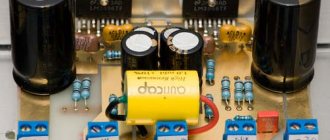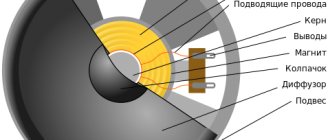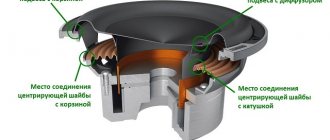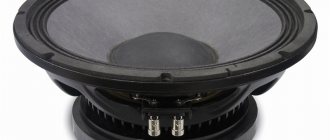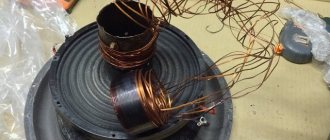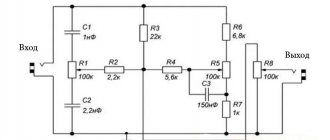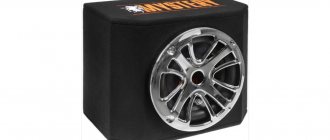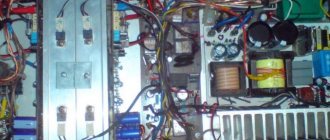Every equipment owner should know how to test a car amplifier for functionality . First you need to check the presence of power at the amplifier terminals, we do this with a multimeter or any car light bulb.
The absence of voltage of 12-14 Volts at the main power terminals of the amplifier indicates:
- about problems with the car wiring;
- with a short circuit in the power supply circuits.
Many car amplifiers, budget class and above, are equipped with a built-in protection system with an indication, which is a red LED, labeled “Protect”. If everything is in order with the power supply in the car’s on-board system, then you need to more carefully repair and restore the device’s functionality at home using a multimeter .
How to check a car amplifier at home
In order to check the performance of a car amplifier at home, you can use any unit with a constant output voltage of 12 to 14 volts, or a computer unit that has the voltage necessary to start the amplifier. The source power must be at least 200 volts and before turning it on, be sure to set the power volume control to minimum. The repair process should always begin with a visual inspection of all radio components on the amplifier circuit board. A standard car amplifier model consists of three main components:
- an input voltage converter unit, which changes the unipolar input voltage of the vehicle's on-board circuit into two polar ones with an increase in voltage up to 20 Volts;
- power amplifier unit, often it is made of bipolar transistors, which are installed on radiators necessary to increase the heat dissipation area. Powerful output stages at maximum power get very hot, so a poor, leaky connection between the transistor plane and the heat sink will certainly lead to its overheating, and, accordingly, to breakdown;
- a frequency control block used to change the sound timbre. A common malfunction of this unit is associated with a deterioration in the smoothness of changes in resistance by variable resistors.
After opening the case, you should carefully inspect every detail of the amplifier, paying special attention to:
- blown fuses. An unbroken fuse-link thread should be visible through the glass flask;
- resistors should not have visible carbon deposits indicating their burnout;
One of the most common malfunctions of failed car amplifiers is related to the breakdown of the inverter power supply. This node consists of:
- input filter capacitors with large capacity;
- pulse transformer;
- transistor converter and microcircuit for acting as an inverting device;
- rectifier diodes working in pairs;
- a smoothing chain consisting of a choke and several electrolytic capacitors.
In any case, any burnt parts found must be replaced with new ones. In this case, neither the fuse nor the resistor installed in the sound-reproducing equipment fails without associated reasons. The condenser may dry out and swell over time. More accurate research and testing of amplifiers is carried out using a millimeter and an oscilloscope.
Why the amplifier does not work - TOP 6 problems and solutions
A properly selected, serviceable car amplifier is the basis for stability and balanced operation of the entire audio system. A solid reserve of power, giving solidity to the sound, helping the acoustics and subwoofer in the car to open up. But things are not always easy for car audio fans - sometimes the fundamental sound is replaced by component failures, extraneous noise and other obvious signs of problems with the amplifier.
Due to the complex design of audio systems, it is not always possible to quickly identify the source and eliminate the malfunction. However, problems with amplifier operation are among the most common. They are quite diverse, and in terms of the nature of distortions, squeaks and extraneous noise, they are quite similar to similar problems of other system components. We have identified six main reasons why the amplifier in your car does not work, as well as possible solutions to each of the problem situations.
Amplifier won't turn on
It is logical that the operation of the amplifier requires uninterrupted power supply with power in the wires and good grounding. If it does not turn on, first of all, check whether the power to the amplifier is lost.
- Remote wire. The first step is to check the voltage on the remote connection wire. A satisfactory value is 5 V. If the voltage is less than 5, pay attention to the wires leading to the main device: integrity of insulation, contacts, condition of fuses;
- Main wire. The next step is to assess the voltage in the power wire. When the engine is turned off, the indicator is about 12 V, when the engine is running - 14.4;
- Grounding efficiency. When the wires are normal, all that remains is to check the grounding. Low or no grounding directly affects the performance of the amplifier.
If none of the above “symptoms” are confirmed, most likely the device has failed and requires complete replacement.
Security system LED flashes
Many models are equipped with a special LED that flashes when the amplifier enters “protection mode”. If this happens, there is likely a problem with the cables or car speakers. The subwoofer may not be working because there is power in the system.
If such a signal is detected, carefully inspect the speakers and subwoofer, check the wire connections, as well as grounding. If the audio system is working properly, the RCA cable may be damaged or not connected correctly. To diagnose the problem, connect the RCA to the head unit and amplifier. If there is no flashing signal, the RCA wire should be replaced.
The amplifier works, but the sound is distorted
In a situation where the amplifier turns on, but the played audio files are accompanied by hissing, crunching, noise, the device already receives distorted sound and amplifies it. A detailed inspection will be required to find the source of the problem. Inspect the connections between the amplifier and speaker cables. Move the wires away from power cables or grounding cables - they can interrupt the signal and cause interference. You can install a more durable and protected wire.
The amplifier turns on but there is no sound
The reason is the lack of output signal from the amplifier. Or the head unit does not provide a signal to the amplifier. See if the device is turned on, turn the volume - the device may simply be turned off.
If there is a connection, you need to look at the quality of the signal from the head unit. To do this, connect the RCA cables to the test blocks. Also, don’t forget to turn on the player and adjust the volume. If the result is satisfactory with new RCA wires, they will need to be replaced. But if one input produces sound and the other is silent, then the head unit needs repair, not the amplifier.
Creak instead of music
What should I do if the sound being played turns into a squeak? This is an indicator that the amplifier is overloaded by the speakers and subwoofer. The cause may also be burnt wires. If the wiring is in good condition, you will have to replace the speakers with weaker ones or choose a more powerful amplifier. Simply measure the power ratings of the two devices. If it is sufficient, then look for the source in the speaker wires, speakers or audio amplifier grounding.
Crackling and wheezing in the speakers
In addition to squeaks, you can hear crackling, popping, knocking and other extraneous noise from the speakers. Problems may lie not only in the amplifier, but also in incorrect installation of the speaker system. For high-quality sound, everything is important: how the speakers are installed, whether the cabinet part of the speakers is suitable for installation.
If everything is fine with them, evaluate the correct matching of the low-frequency acoustics impedance. Do they match? Then check their rated power and adjust the power supply to the amplifier. There is a possibility that you will need a stronger speaker or, conversely, a reduction in the supplied power. Adjust and adjust the sound characteristics until the sound interference disappears.
“AutoCenter” reminds you that a modern amplifier is a complex piece of equipment that requires careful and correct diagnostics in case of problems. Together we can determine the probable malfunction at our service center in Kharkov. Based on the results of gentle diagnostics, it will be more clear why the equipment is not working - whether service is possible or whether you will need to buy a car amplifier to correct the situation.
How to check a car amplifier with a multimeter
Before checking the sound amplifier for functionality, you need to use a multimeter to determine if there is a short circuit in the power supply circuits, which could occur as a result of a breakdown of a semiconductor diode or transistor.
To check the operation of the audio amplifier, or rather its inverting and pulsation-smoothing unit, you need to set the multimeter to current measurement mode and connect it in series to the power circuit. The operating current should be in the range of up to 500mA (that is, 0.5 A). If this value goes off scale, then the power supply installed inside the amplifier has probably failed, or rather a breakdown of the power circuit.
Low bass output.
- If two subwoofers are used, they can have reverse polarity. Then frequency compensation occurs and the low-frequency signal level becomes lower. Look at the "Reverse" button on the back of the subwoofer. Press the button once to switch the polarity. Both speakers are now the same polarity and the low frequency signal level will increase.
- The subwoofer may not reproduce bass because... a signal with an insufficient level of low-frequency component comes from the signal source. Turn the "Bass" knob on the source to its maximum position.
- If increasing the low-frequency signal level at the source does not bring results, you need to increase the signal level at the subwoofer itself. Turn the “Level” control on the rear panel of the subwoofer. Continue turning the knob until the bass level is satisfactory. Next, slowly turn the “Crossover frequency” knob in any direction and listen to select an acceptable tone level.
How to test an audio amplifier with a multimeter
In order to correctly and with a high degree of probability find a failed output stage transistor, thereby checking the sound amplifier, it is best to unsolder each of these semiconductor devices. However, this procedure is very labor-intensive and will take a lot of time, so the output transistors are checked directly on the circuit board, switching it to resistance measurement or continuity testing. If, when connecting the multimeter chips to the legs, the resistance in one direction and the other is the same or very low, then this means the transistor is broken and requires replacement.
You can also ring diodes, which must pass current in one direction, that is, if you touch the ohmmeter probes in one direction, the resistance should be low, then in the other direction it should be more than 100 kOhm.
Do not forget that before you check the sound amplifier for functionality with a multimeter, or rather with an ohmmeter, you need to turn off the power.
You can ring the emitter circuit of the output stage, but to do this you need to know the wiring of the transistors, that is, where its base, emitter and collector are. Checking the sound amplifier involves touching the emitter of the output stage transistor with one probe, and the terminal going to the speaker with the other. The continuity test should show zero resistance or a value close to it. Even a person unfamiliar with electronics can understand how to test an audio amplifier with a multimeter.
Features of online purchasing
Online there is an additional risk of running into a scammer, in order to protect yourself as much as possible and buy a used subwoofer without wasting your nerves, follow the following recommendations:
- purchase goods through advertisements on large, specialized forums. They generally care about the quality of transactions and set trading rules with an emphasis on combating fraud;
- try to purchase equipment from a seller with a good rating, or try to find a guarantor or people who have already made purchases from this person. But it’s not difficult to do this on forums;
- check other threads and messages from the seller;
- ask for additional photographs of the product with the number and name written by hand, if for some reason these were not included in the ad;
- ask for additional photographs from the required angles to visually assess the condition of the case, magnet, suspension, coil, etc.;
- when purchasing for a large amount, there is a practice of a guarantor, when the money is transferred to a third party (a well-known and authoritative person), who gives it to the seller after the buyer confirms receipt of the goods;
- do not hesitate to ask for a photo of the seller’s passport;
- choose a method of money transfers with identification of the recipient (for example, transfers where you need to indicate the recipient’s passport details).
How to check the audio amplifier in a radio
To figure out and understand how to check whether the sound amplifier in the radio is working or not, you need to apply an algorithm similar to checking a car amplifier. That is:
- check the presence of power and short circuit in the power supply system;
- carefully inspect the circuit board for the presence of clearly failed elements and radio components;
- check the tight fit of the radiator to the transistors and microcircuits of the output stages.
There are many ways and techniques for ringing a sound amplifier, but not all specialists want to reveal the secret of finding a fault.
Troubleshooting before car amplifier repair
Before you start work, you need to find out what is broken. Only by determining which part caused the system to stop can it be restored. The electrical circuit will not work if there is no contact, the connection is not in the place where it is intended.
To detect a malfunction caused by a lack of sound, diagnostics begin with a frequency amplifier. To get acquainted with the circuit you will have to remove the cover. Using a magnifying glass, examine the components. If a capacitor or track is burnt out, the wiring does not hold, this is quite clearly visible. It also happens that the problem is not visible here.
Scheme and testing method
The output of the amplifier under test is loaded with an active resistance equal to the rated load of 4, 8, 16 or 32 ohms and capable of dissipating the rated output power of the amplifier.
The output of the generator is connected to the linear input of the amplifier. The output level of the generator is selected so that when the amplifier volume control is partially open, a signal with an amplitude of 1-2 volts is obtained at the oscilloscope input. It is not recommended to fully open the volume control for this type of measurement to prevent saturation of the amplifier's transistor stages.
The quality of the rectangular signal, in particular its edges, is not critical, because if there is distortion introduced by the amplifier, this will be clearly visible on the oscillogram.
A rectangular signal has a frequency spectrum rich in harmonics and, to be honest, theoretically, for its ideal reproduction it is necessary that the upper limit of the amplifier’s frequency range be located somewhere at infinity, in which case the signal fronts will be perfectly rectangular.
In practice, if some frequencies are not passed at all or are passed worse, then the shape of the output signal is modified. The shape also changes if phase distortion occurs between certain frequencies or frequency bands in the spectrum, or if the amplifier introduces large nonlinear distortions, or is self-excited.
HELP! The amp suddenly stopped working((((
Greetings to all car audio enthusiasts and professionals! We need your help! This is my problem! The amplifier suddenly stopped working(((To begin with the equipment characteristics: Amplifier Characteristics Lightning Audio LA-4100: Maximum power 100 Watt x 4 @ 4-Ohm, 200 Watt x 4 @ 2-Ohm, 400 Watt x 2 @ 4-Ohm Built-in crossover CH1/CH2: 12dB/octave FULL/LP/HP High-pass filter: 60Hz - 1.2kHz Low-pass filter: 30Hz - 250Hz CH3/CH4: 12dB/octave FULL/LP/HP High-pass filter: 60Hz - 1.2kHz Low-pass filter : 30Hz - 250Hz Tone control Front: 0dB - +12dB at 45Hz Rear: 0dB - +12dB at 45Hz High-level input: L/R Pins Line input: (4) RCA Line output: (2) RCA Pass Thru Sub connected to it Characteristics Sony XS-LE121C : Peak power, IEC 268-5 (W) 1000 Nominal power, IEC 268-5 (W) 300 Frequency response (Hz) 32.5 - 3000 Impedance (Ohm) 4 Sensitivity (dB/W/m ) 86 Diaphragm material Polypropylene Magnet material Ferrite Impedance (Ohm) 4 And there is also a capacitor Characteristics of Cadence CAP2DR: Capacity 2 farads Maximum voltage 24 volts Built-in digital voltmeter Built-in reverse polarity protection
Now the actual problem! I came in the morning, got into the car, started it, turned on the music and saw that the capacitor voltmeter had less voltage than usual, namely 13.5V, although it always showed 14.0-13.7V, depending on the volume. I turned off the radio just in case and drove to work in silence. When I parked the car, I noticed that the voltmeter on the capacitor did not show anything, but simply flickered. I turned on the radio to try and then misfortune befell me. The subwoofer stopped working. And the power indicator on the amplifier is not constantly on, but flickers a little in time with the music. I decided that the capacitor was to blame and turned it off, but nothing changed! And even when the radio is turned on, the power indicator lights up, and if you disconnect the interconnect cable, it goes out! Please help me with this problem!
Source
What power should I choose for a subwoofer in my car?
As a rule, for normal sound of a subwoofer in a car, 150-300 watts are enough, for hair to move and the bass to be felt throughout the body, 300-600 watts, and anything higher is for fans or the deaf. Subwoofer sensitivity is the sound pressure in dB that a given speaker can reproduce. The higher the better.
Interesting materials:
How to prime walls for liquid wallpaper? What to feed 10 day old broiler chickens? What to feed two week old quails? What to feed newly hatched chickens? What to feed Vietnamese? What is the best way to clean an acrylic bathtub? What is the best way to clean the outside of a refrigerator? What is the best way to finish the wall behind the battery? What is the best way to wash kitchen towels? What is the best way to plaster a cold balcony?
